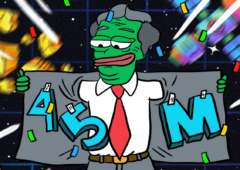Economist Who Called 1987 Crash Warns Markets Face Growing Risk
09.06.2025 17:00 2 min. read Alexander Stefanov
Mark Skousen, the economist who foresaw the 1987 market collapse, believes the current financial environment is entering a precarious phase.
In a recent interview with David Lin, he warned that structural weaknesses and rising uncertainty could soon test global markets.
Rather than an isolated shock like ‘Black Monday,’ Skousen sees today’s risks as systemic and slow-building. He points to shaky economic policies, deteriorating investor confidence, and a weakening dollar as early signs of deeper instability. Although past Federal Reserve actions, such as the aggressive liquidity boost in 2020, helped avoid short-term damage, they’ve also fueled longer-term inflation pressures.
Skousen voiced concern over the gap between rising Treasury yields and a falling dollar—a disconnect he interprets as declining faith in U.S. financial leadership. He partly attributes this to ongoing trade wars and political dysfunction, arguing that uncertainty over U.S. policy is pushing investors toward safer assets like gold.
The economist also flagged overreliance on leverage and fractional reserves as serious vulnerabilities. A single institutional failure, he warned, could trigger a wider crisis.
Recession fears persist despite progress in U.S.-China trade talks. While JPMorgan has lowered its 2025 recession odds, others remain bearish. Economist Steve Hanke, for example, continues to forecast a 90% chance of a downturn, citing long-lasting effects from past trade policies.
Skousen’s bottom line: markets are more fragile than they appear, and the wrong policy move could be enough to spark the next major disruption.
-
1
Japan’s Inflation Hits 3.5% as Food Prices Soar and Tariff Risks Loom
23.05.2025 21:00 1 min. read -
2
US Dollar Dominance Under Threat Amid Yuan’s Global Ambitions
22.05.2025 14:00 2 min. read -
3
Wall Street Analyst Sees Bright Side of Ballooning U.S. Debt
30.05.2025 8:00 2 min. read -
4
Billionaire Warns U.S. Debt Crisis Could Deepen After New Bill
28.05.2025 15:00 1 min. read -
5
Dollar Decline on the Horizon as Fed Pivot Looms, Morgan Stanley Warns
26.05.2025 17:00 1 min. read
Dollar Dominance Fades: Asia Turns to Local Currencies and BRICS Bloc
Across Asia, the U.S. dollar is rapidly losing ground as countries intensify efforts to reduce reliance on the greenback.
JPMorgan Warns U.S. Economy May Be Slowing Behind the Headlines
Despite encouraging job numbers on the surface, JPMorgan Chase’s chief global strategist David Kelly says the U.S. economy is quietly losing momentum.
Recession Odds Still High if Trump Doesn’t Reverse Course, Analyst Warns
Despite solid employment data and improving trade sentiment, BCA Research’s Peter Berezin isn’t convinced the U.S. is in the clear.
Push for Rate Cuts Fuels Speculation Over Powell’s Successor
Kevin Warsh, a former member of the Federal Reserve’s Board, has become a key figure in speculation about who might lead the U.S. central bank next.
-
1
Japan’s Inflation Hits 3.5% as Food Prices Soar and Tariff Risks Loom
23.05.2025 21:00 1 min. read -
2
US Dollar Dominance Under Threat Amid Yuan’s Global Ambitions
22.05.2025 14:00 2 min. read -
3
Wall Street Analyst Sees Bright Side of Ballooning U.S. Debt
30.05.2025 8:00 2 min. read -
4
Billionaire Warns U.S. Debt Crisis Could Deepen After New Bill
28.05.2025 15:00 1 min. read -
5
Dollar Decline on the Horizon as Fed Pivot Looms, Morgan Stanley Warns
26.05.2025 17:00 1 min. read


